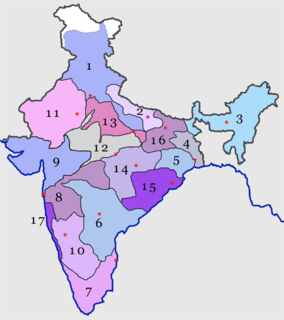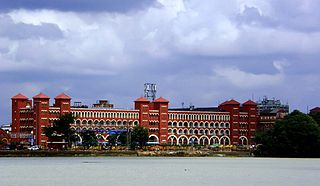
Chhatrapati Shivaji Maharaj Terminus, formerly known as Victoria Terminus, is a historic railway station and a UNESCO World Heritage Site in Mumbai, Maharashtra, India which serves as the headquarters of the Central Railways. The station was designed by Frederick William Stevens according to the concept of Victorian Italianate Gothic Revival architecture and meant to be a similar revival of Indian Goth architecture. The station was built in 1887 in the Bori Bunder area of Mumbai to commemorate the Golden Jubilee of Queen Victoria. The new railway station was built to the south of the old Bori Bunder railway station. It is one of the busiest railway stations in India, serving as a terminal for both long-distance trains and commuter trains. The station's name was changed from Victoria Terminus to Chhatrapati Shivaji Terminus in March 1996 in honour of Emperor Chhatrapati Shivaji, founder of the Maratha Empire. In 2017, the station was again renamed Chhatrapati Shivaji Maharaj Terminus. However, both the former name “VT” and the current name “CST” are popularly used.

The East Coast Railway is one of the 18 railway zones of Indian Railways. It came into existence on 1 April 2003. As the name suggests, most of the railway routes of the zone are near the east coast of India. The headquarters of the zone are at Bhubaneswar.

Indian Railways (IR) is India's national railway system operated by the Ministry of Railways. It manages the fourth largest railway network in the world by size, with 67,368-kilometre (41,861 mi) route.. Routes are electrified with 25 KV AC electric traction while thirty three percent of them are double or multi-tracked.

Lahore Junction railway station is the main railway station in Lahore, Pakistan. Construction commenced shortly after the Mutiny of 1857 against British rule, and so was built in the style of a medieval castle with thick walls, turrets, and holes to direct gun and cannon fire for defence of the structure. The station is now owned by Pakistan Railways, and also serves as its headquarters.

The Western Railway is one of the 18 zones of Indian Railways, and is among the busiest railway networks in India. The major railway routes of Indian Railways which come under Western Railways are: Mumbai Central - Ratlam, Mumbai Central - Ahmedabad and Palanpur - Ahmedabad. The railway system is divided into six operating divisions: Vadodara, Ahmedabad, Rajkot, Bhavnagar, Ratlam, and Mumbai Central. Vadodara railway station, being the junction point for the Ahmedabad - Mumbai route and the Mumbai - Ratlam route towards New Delhi, is the busiest junction Station in Western Railways and one of the busiest junctions of Indian Railways too, while Ahmedabad Division earns highest revenue followed by Mumbai Division and Vadodara Division. Surat railway station is one of the busiest railway station in Western Railway in non-junction category where more than 160 trains pass per day.

Howrah Junction, more popularly known as Howrah Station, is the oldest and largest railway complex in India, serving the twin cities of Howrah and Kolkata. Approximately 617 passenger trains pass through the station each day requiring its 23 platforms and serving more than two million passengers per day with the highest train handling capacity of any Indian railway station. Howrah Junction is one of five intercity railway stations serving the city of Kolkata, the others being Sealdah, Santragachi, Shalimar, and Kolkata railway station. The station is located in Howrah on the west bank of the Hooghly River. 1373 stations across India are directly connected to Howrah Railway Station.

The Northern Railway is one of the 18 Railway zones of India and the northernmost zone of the Indian Railways. Its headquarter is New Delhi Baroda House near India Gate.

The North Central Railway is one of the 18 railway zones in India. The largest railway station in NCR is Kanpur Central. It is headquartered at Allahabad and comprises three divisions: reorganized Allahabad division of the erstwhile Northern Railway, Jhansi division of the erstwhile Central Railway, and new Agra division.

Chennai Central, erstwhile Madras Central, is the main railway terminus in the city of Chennai, Tamil Nadu, India. It is the busiest railway station in South India and one of the most important hubs in the country. It is connected to Moore Market Complex railway station, Chennai Central metro station, Chennai Park railway station, Park Town railway station and is 2 km from Chennai Egmore railway station. Chennai Central connects the city to all northern cities of India, including Kolkata, Mumbai and New Delhi.

Bangalore City railway station, officially known as Krantivira Sangolli Rayanna railway station, is the main railway station serving the city of Bengaluru, Karnataka, India. It is the fourth busiest railway station in South India after Chennai Central,Chennai Egmore and Tambaram Railway Station

Mirpur Khas railway station is junction located in middle of the Mirpur Khas, Sindh, Pakistan on Hyderabad - Khokhrapar branch railway line. The station is staffed and has booking office.

Vehari railway station is located in middle of the Vehari, Punjab, Pakistan. The station is staffed and has a booking office.

A train station, railway station, railroad station, or depot is a railway facility or area where trains regularly stop to load or unload passengers or freight. It generally consists of at least one track-side platform and a station building (depot) providing such ancillary services as ticket sales and waiting rooms. If a station is on a single-track line, it often has a passing loop to facilitate traffic movements. The smallest stations are most often referred to as "stops" or, in some parts of the world, as "halts".

Lucknow railway station is one of the two main railway stations of Lucknow city for broad gauge trains, other one is "Lucknow Jn".
Landhi railway station is one of three major railway stations in Karachi, Pakistan. It is situated in the east end of the city near Quaidabad in Landhi and serves as a major stop along the Karachi–Peshawar Railway Line.

The New Delhi Railway Station, situated between Ajmeri Gate and Paharganj is the main railway station in Delhi. It is the one of the busiest railway stations in the country in terms of train frequency and passenger movement. Around 400 trains start, end, or passes through the station daily, which handled 1,68,370 passengers daily with 16 platforms. The New Delhi railway station holds the record for the largest route interlocking system in the world along with the Kanpur Central Railway Station i.e. 48. The station is about two kilometres north of Connaught Place, in central Delhi.

Islamabad railway station is located in sector I-9 Islamabad, Capital Territory, Pakistan. The station appears as Margala on the Pakistan Railways website.
Bangalore railway division is one of the three railway divisions under South Western Railway zone of Indian Railways. This railway division was formed on 5 November 1951 and its headquarter is located at Bangalore in the state of Karnataka of India.















